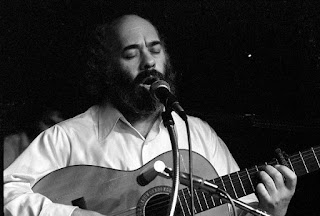By Paul Shaviv, Guest Contributor
 |
| Shlomo Carlebach |
I received the following tribute to Shlomo Carlebach from Paul Shaviv. Carlebach was a controversial figure during his lifetime and even now. Without getting into details let us just say that the kind of personal behavior he had with some women is the subject of much discussion of late. This is the ‘dark side’ referred to by Paul and it is the primary reason he was so controversial. Nonetheless, it is clearly a fact that when it came to Jewish Music he had no peers. He is clearly the ‘Beethoven’ or ‘Beatles’ of Jewish music in our day. No one else can come anywhere close.
I love his music. He was the most prolific Jewish songwriter of our time. His musical compositions are more widely used in Orthodox circles than anyone else’s music by far. It is utilized by all segments of Orthodoxy and even non Orthodox communities. Many Sheluchei Tzibur (people that lead the services) do not even realize the tune they adapt to various prayers are actually Carlebach compositions. His music is also part of any decent Jewish band’s repertoire.
An unfortunate offshoot of his influence is the near idol worship he has inspired in some people. Although the author of this post will probably not agree with me, the advent of Carelbach Minyanim is a symptom of that in my view. With all of this in mind, I present Paul’s tribute to Carlebach in full. It follows.
This Sunday, Heshvan 16 (November 5th) is the 23rd Yahrzeit of Shlomo Carlebach, who died of heart failure at the age of 69. I never knew him, and saw him only once, briefly, at a restaurant in Jerusalem.
But he is a major figure in Jewish life.
Yes, he was controversial, and, yes, there was a dark side. But in life he managed to touch a nerve which few others were able to; and in death his musical influence is greater than ever. Many shuls which would have avoided having him appear in his lifetime now enthusiastically promote ‘Carlebach minyanim’; and almost every ba’al tefillah, right across the spectrum, knowingly or unknowingly, uses his tunes.
Shlomo came from impeccable yekke rabbinic stock, with roots in Germany and, later, Austria. He escaped to the USA in 1938, where he attended YTorah v’Daas and was then an early student at Lakewood. He was regarded as a genius. However, he gravitated to Chabad, and became a hassid of the Sixth Rebbe, Yosef Yitzchak. The Rebbe sent him out with Zalman Schachter z”l as the first ‘shluchim’ to Jewish students on campuses.
They were perhaps the first to reach the ‘countercultural Jews’. Throughout the ‘50’s, ‘60’s and ‘70’s, thousands of young Jews deserted Judaism and flocked to the teachers of (Americanized) ‘Eastern religions’. It seemed as though Judaism had nothing to say to them. The brief encounters with the ‘JuBus’ (Jewish Buddhists) portrayed in Rodger Kamenetz’ classic ‘The Jew in the Lotus’ are searing. In my memory is the Jewish Buddhist nun from Dublin who spent sixteen years in ‘exile’, subsisting on food scraps and charity. A far cry from Lakewood.
Shlomo understood them, and his music reached them.
He spent years and years on an endless, restless, peripatetic one-man non-stop world tour, reaching out to his ‘Holy Hippelach’ with message of kindness, joy and love. He touched the lives of thousands, and had the ability to transmit deep messages in brief, even momentary encounters.
Stories of his hessed to Jews and non-Jews are countless. His personal life, and his financial affairs, were chaotic. Those closest to him – among them Arye Coopersmith and Shaul Magid – are the first to acknowledge that they knew him the least, painting him as a complex, semi-tragic figure. His music hid a great deal.
By contrast, his early partner, Zalman Schachter (later Schachter-Shalomi) was far more radical, hurtling off into a syncretic orbit combining Hasidism, Sufism, Buddhism and any other spiritual tradition which spoke to him. He would appear in shtreimel, bekishe and tallit at American Indian ceremonies, chanting or ‘davenning’ in several languages. From his Jewish following the ‘Jewish Renewal’ movement arose – touchy-feely, eco-conscious, meditative, story-telling, flourishing in woodland retreats – you get the picture!
Both of these stories upset me.
And they upset me because both highlight our failures as a community – failures which persist to this day. There is an entire world of Jews whom we fail to reach. While we obsess over halachic fads and fashions (one year Indian sheitels, next year bugs in lettuce, then Brakel chickens, then smartphones, then pictures of women…), accompanied by violence in speech and sometimes deed, our community is dying. Yes, as someone pointed out, Orthodoxy is booming – but while more people are eating (hideously expensive) Shemurah matzah, fewer people are eating matzah.
Today, there are few people really reaching out in the Orthodox community. Shlomo remains controversial. There are fascinating shiurim by the always impressive Rav Aaron Rakeffet-Rothkopf on YU Torah about how various Gedolim related to Shlomo and his music. His personality and way of doing things (still less that of Reb Zalman) would not be acceptable in today’s ever-stricter community. Antagonism, spite, meanness seem to be our daily bread.
The only group who practice that non-judgemental, unconditional love to the entire Jewish people seem to be Chabad.
Maybe they are the future?